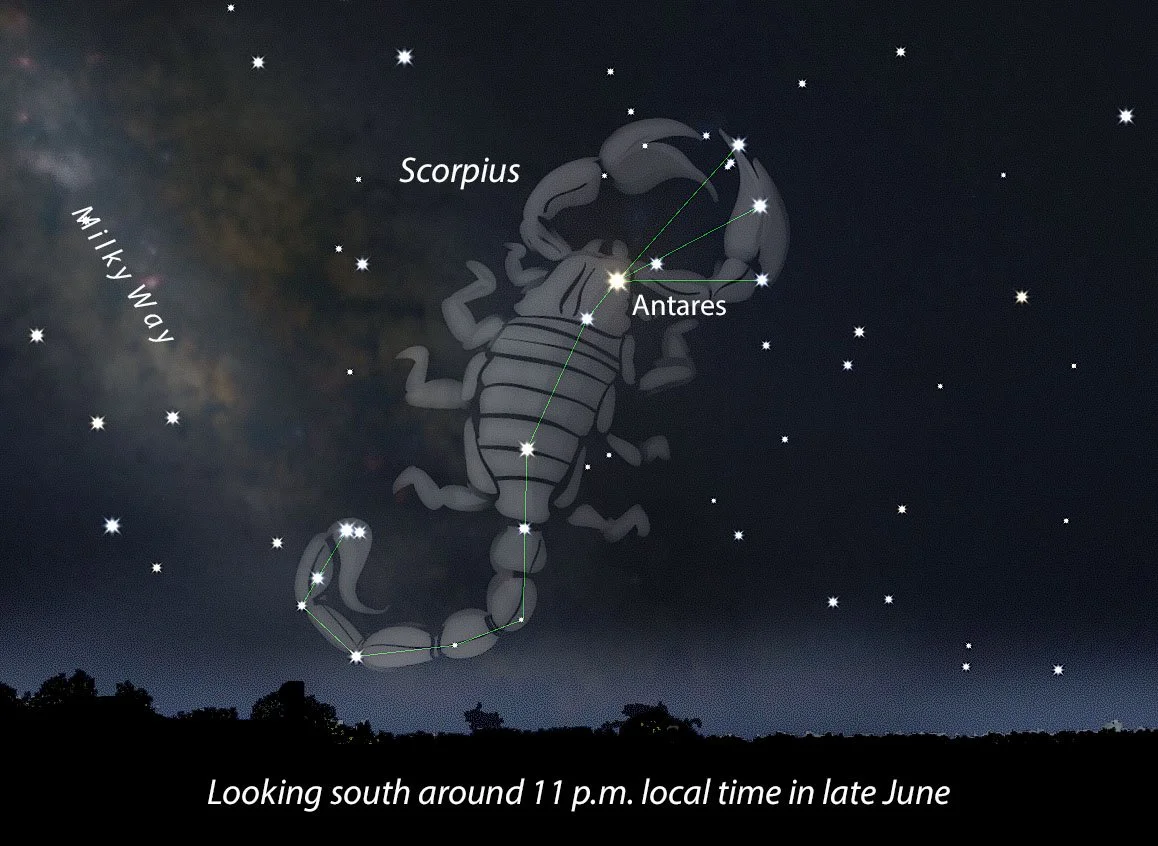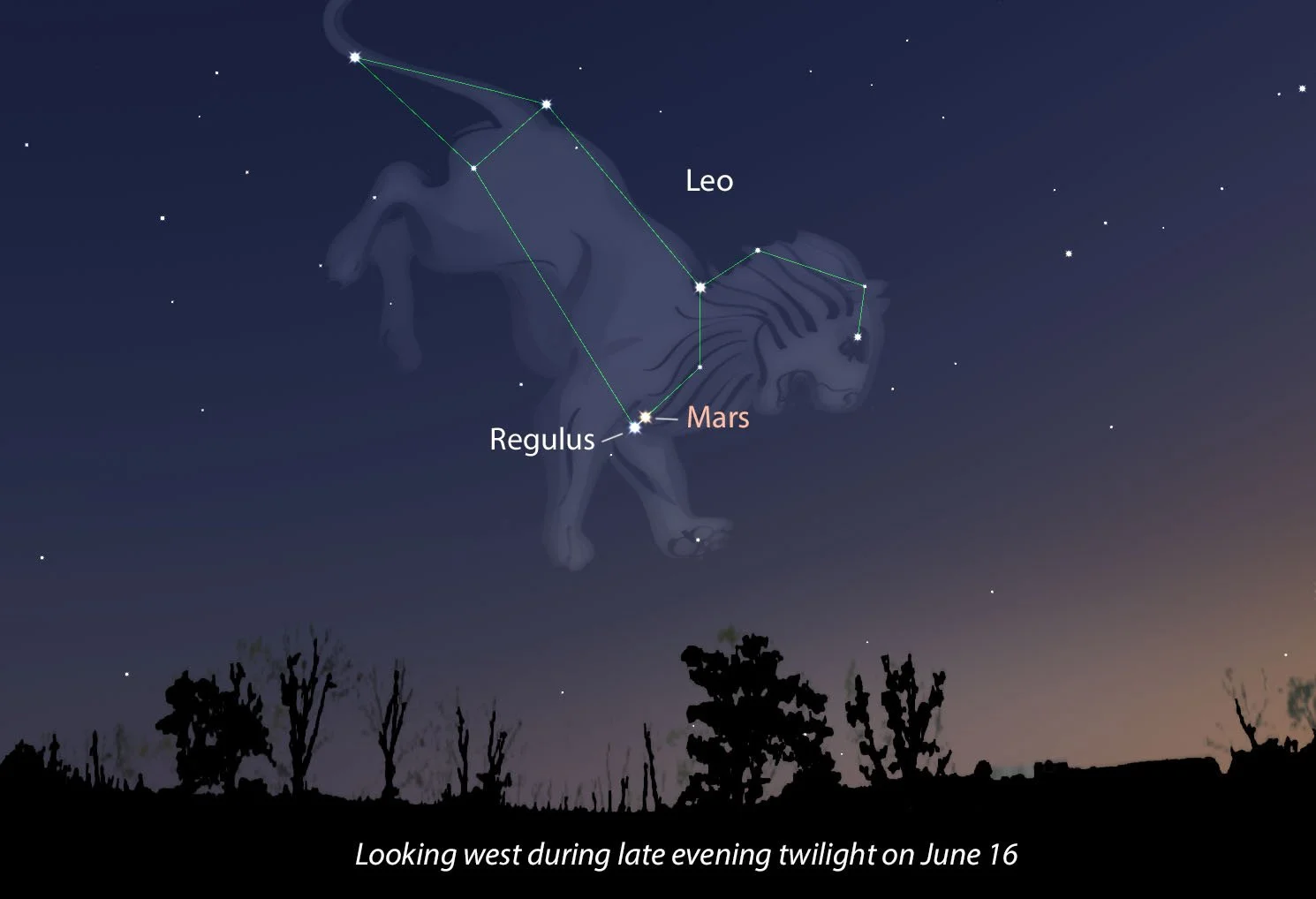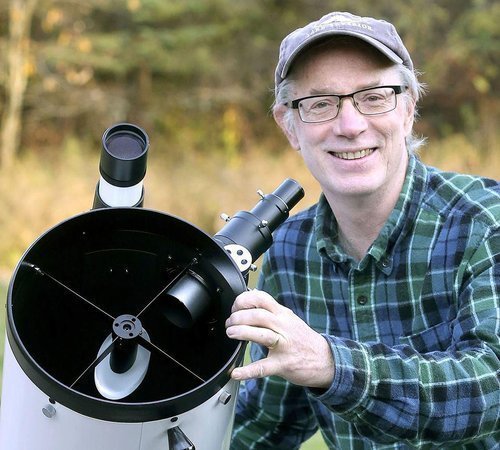June 2025 Night Sky Calendar
June 2025 Night Sky Explorer by Bob King
Finally. No more gloves at night to ward off the chill. Even May nights occasionally get cold enough to require finger protection. With the fear of freezing behind us, biting bugs lie ahead. When you’re out stargazing don’t forget to bring mosquito repellent. I’ve taken to wearing lightweight gloves made of rubberized material that mosquitos can’t penetrate. I don a cap and a coat with the collar zipped up to my chin. Only my face and ears exposed, which I dab with bug spray.
Astronomically speaking, June is laid back. No meteor showers of note, no eclipses and no bright comets are expected. But cosmic bodies are always on the move, guaranteeing some pretty conjunctions in the weeks ahead. The best occurs on June 16 between Mars and the star Regulus.
Jupiter disappears in the twilight glow, making Mars the sole evening planet unless you count Mercury. The smallest planet makes a brief appearance at dusk low in the northwestern sky at mid-month. Venus and Saturn entice observers to rise at dawn, when they light up the eastern sky.
June and July are ideal for seeing noctilucent, or “night-shining,” clouds. They appear very low in the northern sky 1-2 hours after sunset (or before sunrise) when the first stars come out.
Noctilucent clouds (NLCs) are best seen from the northern U.S. and higher latitudes. Unlike ordinary clouds, which typically top out around 6-7 miles altitude, NLCs are around 50 miles high. Their exceptional height means they still reflect sunlight long after lower clouds have faded to gray.
While they resemble feathery cirrus clouds, they glow blue and have a delicate ripple-and- strand texture. Regular clouds form when water condenses onto tiny grains of dust, salt or volcanic particles. NLCs form when water condenses on meteor dust, volcanic particulates and even rocket exhaust.
Our featured constellation is Scorpius, which raises its fearsome head in the southeastern sky at dusk. The same way Leo sorts of looks like a lion, Scorpius looks like a scorpion. It even has a red heart, the star Antares. Early in the month, the full constellation stands above the horizon in the southern sky around 1 a.m. local time. In late June, it gets there around midnight. In ancient mythology, Scorpius stung Orion to death as payback for bragging about his hunting skills.
Download the free Stellarium Mobile app for Android and iPhone to help you find and identify the current planets and constellations. Do a Google search, then install the app, set it in night mode (red screen) and point your phone skyward. For a free June sky map and calendar go to www.skymaps.com/downloads.html I also update on auroras and other sky events on Facebook at https://www.facebook.com/astrobobking/
Events (a.m. indicates the event happens in the morning sky):
June 1 – Thick crescent moon in close conjunction with Regulus, Leo’s brightest star. The two will be only about one moon-diameter apart at dusk. Cover the moon with your fingertip for a clearer look at Regulus.
June 2 – First quarter moon. At this phase, the half-moon stands high in the southern sky at sunset.
June 5 – Waxing gibbous moon shines to the right (west) Virgo’s brightest star, Spica.
June 8-20 – Mercury visible in Gemini very low in the northwestern sky 45 minutes after sunset. Use binoculars!
June 9 – Waxing gibbous moon shines a few degrees to the upper right of Antares, the red supergiant star that marks the heart of Scorpius the scorpion.
June 10 – Full Strawberry Moon. Rises around local sunset and sets the next morning around sunrise. Named for a favorite wild berry that ripens this month.
June 16 – Mars and Regulus in close conjunction less than 1 degree apart. They’ll be almost identical in brightness but differ in color – white for Regulus and red for Mars.
June 18 (a.m.) – Last quarter moon. The half-moon stands due south around the time of sunrise.
June 19 (a.m.) – Last quarter moon shines a few degrees to the right of Saturn.
June 20 – Summer solstice at 9:42 p.m. CDT. In the Northern Hemisphere we experience the longest day and shortest night of the year. The sun also reaches its greatest height in the sky around 1 p.m. Daylight Time.
June 21-22 (a.m.) – Waning crescent moon shines near Venus on both mornings. Watch at dawn.
June 21-30 (a.m.) – For early-risers, the International Space Station (ISS) begins a round of dawn sky-crossings. For a complete list of passes for your city, log in to Heavens-Above.com, select your location and then click the blue ISS link. Or download and install NASA’s Spot the Station app at the app store or Google Play.
June 25 – New Moon. The moon lies in the same direction as the sun and is invisible in the daytime sky.
June 29 (a.m.) – Conjunction of Saturn and Neptune, the first of three in a rare triple conjunction. If it’s cloudy, they’ll be near each other for several mornings around this date, making for plenty of opportunities to see them in the same binocular field of view.
June 29 – Crescent moon and Mars in close conjunction just three-quarters of a degree apart. Look as soon as it gets dark.
Hoping your nights skies are clear! --- Bob
Bob King is an amateur astronomer, author, and passionate educator. He served as a photographer and photo editor at the Duluth News Tribune for 39 years and taught at the UMD planetarium. Bob’s work had a great impact on Voyageurs National Park. To achieve International Dark Sky Park certification, the park was required to host dark sky education events. Through the Night Sky Explorer webinars, the Conservancy was able to fulfill this component and help secure the certification for Voyageurs National Park. We can’t thank Bob King enough for sharing his talents and knowledge with the Conservancy community to support dark sky preservation.






